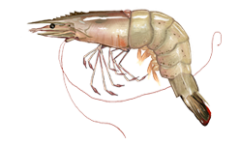
Shrimp
Catching Shrimp:
Life Cycle
Shrimp spawn offshore between March and September. The post-larval stage takes about 15 to 20 days after spawning. At the time the shrimp migrate inshore and become juveniles until they migrate offshore during the following spring and summer.
Catching Shrimp with Traps:
Minnow traps will work for shrimp. Purchase or make your own bait. Make bait from groundfish parts, fish oil with a binding agent such as fish meal or clay. The bait holder should not allow the bait to wash away. The most common bait is a mixture of powdered clay and fish meal (typically ground menhaden). Make homemade bait from flour, or cornmeal, and cat food. Binding agents that work are clay or Portland cement. The balls range in size from a tennis ball to a softball and are typically flattened out to a hamburger shape. I wear plastic gloves when mixing bait so that my hands don’t smell. Make or buy a bait holder. A cup with a lid and many holes in the wall are excellent bait holders. I’ve also seen cheesecloth or similar material used. Secured the bait container to the floor of the trap.
Catching Shrimp with Cast Nets:
Another technique is baiting and cast netting. Drive PVC poles into the bottom to mark a spot. Place bait patties near the pole to draw in shrimp. Cast net near the pole to catch the shrimp.
Regulations:
Shrimp Trap Guidelines
- Harvesters can use up to four shrimp traps.
- Shrimp traps cannot exceed the following dimensions: 36 inches long by 24 inches wide by 12 inches high. Shrimp traps also cannot have external or unattached wings, weirs or other devices intended to funnel shrimp into the trap.
- The harvester’s name and address shall be securely affixed to each trap. Any trap not having proper identification is subject to confiscation by the commission.
- Any shrimp trap on public property which is not attended by the person whose name is on the trap is subject to confiscation by the commission.
Baiting Information
A person recreationally harvesting shrimp may use a cast net with non-metal poles to bait shrimp while adhering to the following rules:
- No more than five poles shall be set at any one time by any person.
- Each pole may not exceed one inch in diameter.
- Poles shall be driven into the bottom, set no closer than 10 yards apart and the distance between the first and last pole shall not exceed 50 yards.
- Poles shall only be set, fished and retrieved during daylight hours. The term “daylight hours” means the period beginning 1/2 hour before official sunrise and continuing through 1/2 hour after official sunset, each day. All poles shall be removed each day by 1/2 hour after official sunset.
- Each pole shall be marked with white reflective tape.
- No pole shall be set within 50 yards of any dock, pier, public boat landing or ramp, seawall, jetty or bridge.
- Tend to poles at all times. The term “tend” means that the harvester is within 100 yards of the nearest pole.
Size limit:
None
Closed season:
The closed season is April and May in Nassau, Duval, St. Johns, Putnam, Flagler, and Clay counties.
Closed areas:
Contact your nearest FWC Law Enforcement office for local restrictions.
Limit:
5 Gallons with heads on.
Life Cycle:
White shrimp progress through several life-history stages in a short amount of time, mature quickly and typically lives for less than a year. Adults live on soft bottoms from the nearshore to depths of a few hundred feet. Unlike many aquatic invertebrates, white shrimp reproduce via internal fertilization. After mating, females release hundreds of thousands of fertilized eggs, which quickly hatch. Planktonic larvae live in the open ocean, and juveniles live in estuaries, before moving to the preferred adult habitat near the age of maturation. Adults live on soft bottoms from the nearshore to depths of a few hundred feet. Like in all decapods, the white shrimp’s shell really is a skeleton on the outside of its body. The exoskeleton does not expand so the prawn must molt (shed) it regularly to grow bigger. Before molting, an individual begins building a new, larger skeleton inside the existing one. As the new exoskeleton gets too big, it splits open the outer shell, and the new exoskeleton hardens. During this process, the new exoskeleton is soft for several hours, and the prawn is highly vulnerable to predation. Adult white shrimp are omnivorous and eat a variety of food, including algal and plant material, other invertebrates, and dead/decaying organic matter. Most soft-bottom fishes and several invertebrates eat juvenile and adult white shrimp.
Commercial Fishery:
This species is also the target of a large fishery throughout most of its range. White shrimp populations are well-managed, and this species is not considered overfished in the United States or in Mexico. Of more concern is the primary gear used to capture shrimp. Bottom trawlers harvest white shrimp and other prawns around the world. This method is known to cause significant damage to seafloor habitat and known to capture an incredible amount of non-target species. Numerous species of sea turtles, sharks, rays, bony fishes and other invertebrates are accidentally captured in shrimp trawls. Species that have been clearly shown as threatened by shrimp trawling include the Northern Red Snapper, the Loggerhead Turtle, and other sea turtles. Bottom trawling threatens other less charismatic species as well. In defense of the shrimping industry, they are the ones who invented the escape vents that allow turtles and larger fish to escape the net. Without continuing advances in the gear used to capture white shrimp and other prawns, ecosystems in their geographic range will continue to directly or indirectly suffer.
